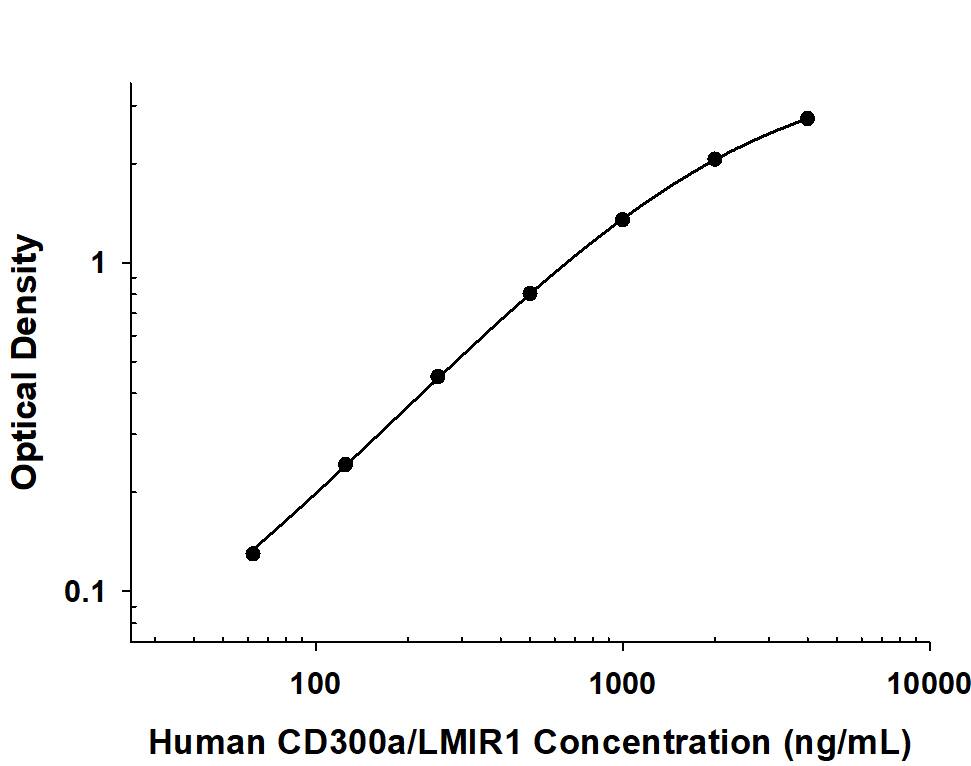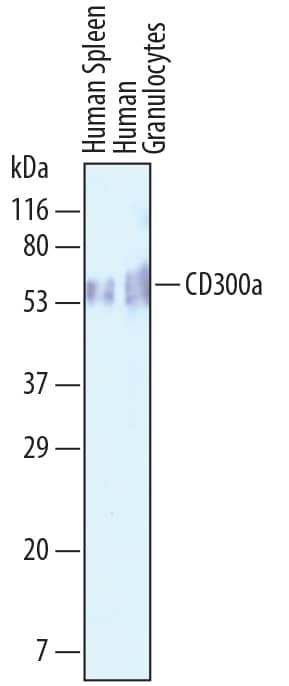Human CD300a/LMIR1 Antibody
R&D Systems, part of Bio-Techne | Catalog # AF2640

Key Product Details
Species Reactivity
Validated:
Human
Cited:
Human
Applications
Validated:
ELISA, Western Blot
Cited:
Bioassay
Label
Unconjugated
Antibody Source
Polyclonal Goat IgG
Product Specifications
Immunogen
Mouse myeloma cell line NS0-derived recombinant human CD300a/LMIR1
Leu18-Gln178
Accession # Q9UGN4
Leu18-Gln178
Accession # Q9UGN4
Specificity
Detects human CD300a/LMIR1 in direct ELISAs and Western blots. In direct ELISAs, less than 2% cross-reactivity with recombinant human (rh) LMIR2, rhLMIR3, rhLMIR5, and rhLMIR6 is observed.
Clonality
Polyclonal
Host
Goat
Isotype
IgG
Scientific Data Images for Human CD300a/LMIR1 Antibody
Detection of Human CD300a/LMIR1 by Western Blot.
Western blot shows lysates of human spleen tissue and human granulocytes. PVDF membrane was probed with 1 µg/mL of Goat Anti-Human CD300a/LMIR1 Antigen Affinity-purified Polyclonal Antibody (Catalog # AF2640) followed by HRP-conjugated Anti-Goat IgG Secondary Antibody (HAF019). A specific band was detected for CD300a/LMIR1 at approximately 55-60 kDa (as indicated). This experiment was conducted under reducing conditions and using Immunoblot Buffer Group 1.Human CD300a/LMIR1 ELISA Standard Curve.
Recombinant Human CD300a/LMIR1 protein was serially diluted 2-fold and captured by Rat Anti-Human CD300a/LMIR1 Monoclonal Antibody (MAB26401) coated on a Clear Polystyrene Microplate (Catalog # DY990). Goat Anti-Human CD300a/LMIR1 Antigen Affinity-purified Polyclonal Antibody (Catalog # AF2640) was biotinylated and incubated with the protein captured on the plate. Detection of the standard curve was achieved by incubating Streptavidin-HRP (Catalog # DY998) followed by Substrate Solution (Catalog # DY999) and stopping the enzymatic reaction with Stop Solution (Catalog # DY994).Applications for Human CD300a/LMIR1 Antibody
Application
Recommended Usage
ELISA
This antibody functions as an ELISA detection antibody when paired with Rat Anti-Human CD300a/LMIR1 Monoclonal Antibody (Catalog # MAB26401).
This product is intended for assay development on various assay platforms requiring antibody pairs. We recommend the Human CD300a/LMIR1 DuoSet ELISA Kit (Catalog # DY2640-05) for convenient development of a sandwich ELISA.
This product is intended for assay development on various assay platforms requiring antibody pairs. We recommend the Human CD300a/LMIR1 DuoSet ELISA Kit (Catalog # DY2640-05) for convenient development of a sandwich ELISA.
Western Blot
1 µg/mL
Sample: Human spleen tissue and human granulocytes
Sample: Human spleen tissue and human granulocytes
Formulation, Preparation, and Storage
Purification
Antigen Affinity-purified
Reconstitution
Reconstitute at 0.2 mg/mL in sterile PBS. For liquid material, refer to CoA for concentration.
Formulation
Lyophilized from a 0.2 μm filtered solution in PBS with Trehalose. *Small pack size (SP) is supplied either lyophilized or as a 0.2 µm filtered solution in PBS.
Shipping
Lyophilized product is shipped at ambient temperature. Liquid small pack size (-SP) is shipped with polar packs. Upon receipt, store immediately at the temperature recommended below.
Stability & Storage
Use a manual defrost freezer and avoid repeated freeze-thaw cycles.
- 12 months from date of receipt, -20 to -70 °C as supplied.
- 1 month, 2 to 8 °C under sterile conditions after reconstitution.
- 6 months, -20 to -70 °C under sterile conditions after reconstitution.
Background: CD300a/LMIR1
References
- Clark, G.J. et al. (2009) Trends Immunol. 30:209.
- Cantoni, C. et al. (1999) Eur. J. Immunol. 29:3148.
- Munitz, A. et al. (2006) Blood 107:1996.
- Bachelet, I. et al. (2005) J. Immunol. 175:7989.
- Alvarez, Y. et al. (2008) Mol. Immunol. 45:253.
- Ju, X. et al. (2008) Blood 112:1184.
- Clark, G.J. et al. (2007) J. Leukoc. Biol. 82:1126.
- Kumagai, H. et al. (2003) Biochem. Biophys. Res. Commun. 307:719.
- Yotsumoto, K. et al. (2003) J. Exp. Med. 198:223.
- Bachelet, I. et al. (2008) J. Immunol. 180:6064.
- Bachelet, I. et al. (2006) J. Allergy Clin. Immunol. 117:1314.
- Munitz, A. et al. (2006) J. Allergy Clin. Immunol. 118:1082.
Alternate Names
CD300a, CLM8, CMRF-35H, IGSF12, IRC1, IRC2, IRp60, LMIR1, MAIR-I, Mcipr1, NKRL, Pigr4
Gene Symbol
CD300A
UniProt
Additional CD300a/LMIR1 Products
Product Documents for Human CD300a/LMIR1 Antibody
Product Specific Notices for Human CD300a/LMIR1 Antibody
For research use only
